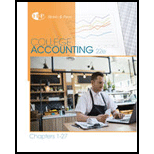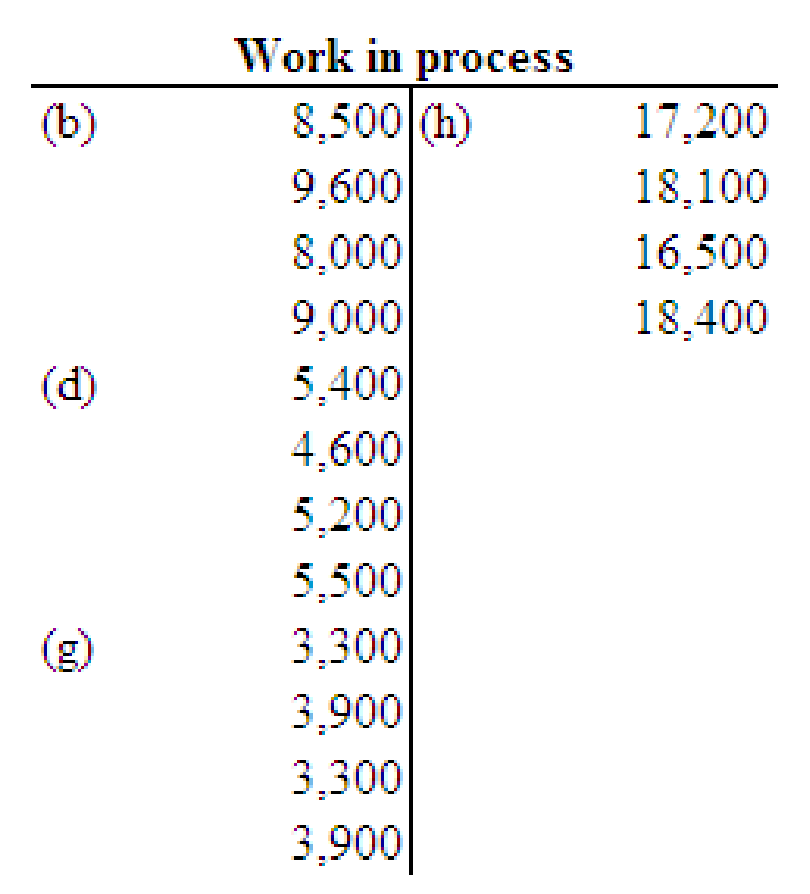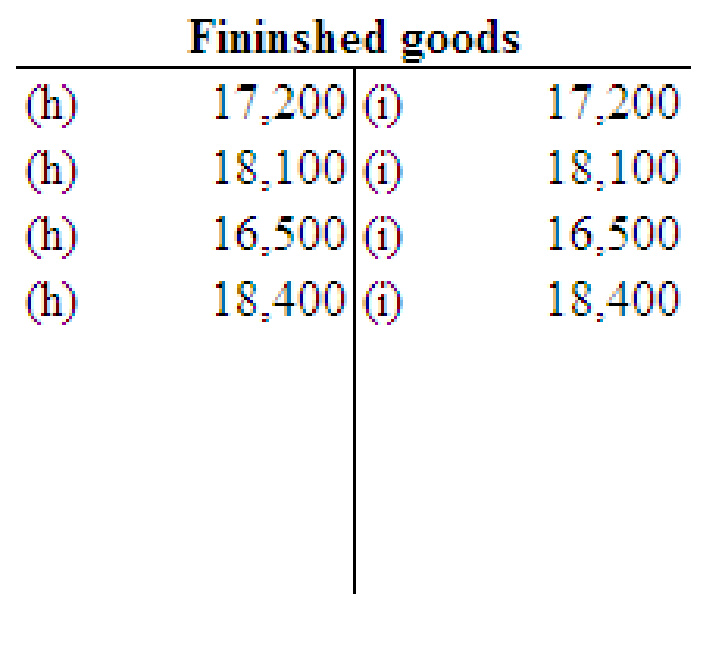
Concept explainers
- (a) Purchased raw materials on account, $44,000.
- (b) Issued direct materials to production:

- (c) Issued indirect materials to production, $5,700.
- (d) Incurred direct labor costs:

- (e) Charged indirect labor to production, $3,400.
- (f) Paid electricity, heating oil, and repair bills for the factory and charged to production, $5,300.
- (g) Applied factory overhead to each of the jobs using a predetermined factory over-head rate as follows:

- (h) Finished Job Nos. 205-208 and transferred to the finished goods inventory account as products L, M, N, and O, respectively.
- (i) Sold products L, M, N, and O, on account, for $21,000, $20,300, $ 19,000, and $20,500, respectively.
REQUIRED
- 1. Prepare general
journal entries to record transactions (a) through (i). Make compound entries for (b), (d), and (g), with separate debits for each job. - 2.
Post the entries to the work in process and finished goods T accounts only.
1.
Prepare general journal entries to record transactions (a) through (i) and make compound entries for (b), (d), and (g), with separate debits for each job.
Explanation of Solution
Job order costing:
Job order costing is one of the methods of cost accounting under which cost is collected and gathered for each job, work order, or project separately. It is a system by which a factory maintains a separate record of each particular quantity of product that passes through the factory. Job order costing is used when the products produced are significantly different from each other.
Prepare journal entry to record the given transactions.
| Date | Accounts title and explanation |
Debit ($) |
Credit ($) |
| a. | Material | 44,000 | |
| Accounts payable | 44,000 | ||
| (To record the purchase of materials on account.) | |||
| b. | Work in process | 8,500 | |
| Work in process | 9,600 | ||
| Work in process | 8,000 | ||
| Work in process | 9,000 | ||
| Materials | 35,100 | ||
| (To record direct materials incurred for the job: job no.205,206,207,208) | |||
| c. | Factory overhead | 5,700 | |
| Materials | 5,700 | ||
| (To record the issuance of indirect materials) | |||
| d. | Work in process | 5,400 | |
| Work in process | 4,600 | ||
| Work in process | 5,200 | ||
| Work in process | 5,500 | ||
| Wages payable | 20,700 | ||
| (To record direct labor incurred for the job: job no.205,206,207,208) | |||
| e. | Factory overhead | 3,400 | |
| Wages payable | 3,400 | ||
| (To record the indirect labor charged to production) | |||
| f. | Factory overhead | 5,300 | |
| Cash | 5,300 | ||
| (To record the payment of electricity bill, heating oil, and repairs bills for the factory and charge made to production) | |||
| g. | Work in process | 3,300 | |
| Work in process | 3,900 | ||
| Work in process | 3,300 | ||
| Work in process | 3,900 | ||
| Factory overhead | 14,400 | ||
| (To record applied factory overhead to the job: job no.205,206,207,208) | |||
| h. | Finished goods (Product L) | 17,200 | |
| Work in process | 17,200 | ||
| (To record the transfer of Job no. 205 to Product L) | |||
| Finished goods (Product M) | 18,100 | ||
| Work in process | 18,100 | ||
| (To record the transfer of Job no.206 to Product M) | |||
| Finished goods (Product N) | 16,500 | ||
| Work in process | 16,500 | ||
| (To record the transfer of Job no.207 to Product N) | |||
| Finished goods (Product O) | 18,400 | ||
| Work in process | 18,400 | ||
| (To record the transfer of Job no.208 to Product O) | |||
| i. | Accounts receivable | 21,000 | |
| Sales | 21,000 | ||
| (To record sale of product L) | |||
| Cost of goods sold | 17,200 | ||
| Finished goods (Product L) | 17,200 | ||
| (To record cost of goods sold on finished goods of Product L) | |||
| Accounts receivable | 20,300 | ||
| Sales | 20,300 | ||
| (To record sale of product M) | |||
| Cost of goods sold | 18,100 | ||
| Finished goods (Product M) | 18,100 | ||
| (To record cost of goods sold on finished goods of Product M) | |||
| Accounts receivable | 19,000 | ||
| Sales | 19,000 | ||
| (To record sale of product N) | |||
| Cost of goods sold | 16,500 | ||
| Finished goods (Product N) | 16,500 | ||
| (To record cost of goods sold on finished goods of Product N) | |||
| Accounts receivable | 20,500 | ||
| Sales | 20,500 | ||
| (To record sale of product O) | |||
| Cost of goods sold | 18,400 | ||
| Finished goods (Product O) | 18,400 | ||
| (To record cost of goods sold on finished goods of Product O) |
(Table 1)
2.
Post the entries to the work in process and finished goods T accounts.
Explanation of Solution


Want to see more full solutions like this?
Chapter 26 Solutions
College Accounting, Chapters 1-27
- What accounting tool is commonly used to track sustainability-related performance? A) Balanced ScorecardB) Trial BalanceC) Journal Entry LogD) Ledger Sheetno aiarrow_forwardWhat accounting tool is commonly used to track sustainability-related performance? A) Balanced ScorecardB) Trial BalanceC) Journal Entry LogD) Ledger Sheetarrow_forwardPrepaid insurance is classified as which type of account? A) ExpenseB) LiabilityC) AssetD) Revenueneedarrow_forward
- Prepaid insurance is classified as which type of account? A) ExpenseB) LiabilityC) AssetD) Revenuearrow_forwardIf a company issues common stock for $10,000 cash, what is the effect? A) Increase assets, decrease equityB) Increase liabilities, increase assetsC) Increase assets, increase equityD) No change in the accounting equationcarrow_forwardIf a company issues common stock for $10,000 cash, what is the effect? A) Increase assets, decrease equityB) Increase liabilities, increase assetsC) Increase assets, increase equityD) No change in the accounting equationneed helparrow_forward
- If a company issues common stock for $10,000 cash, what is the effect? A) Increase assets, decrease equityB) Increase liabilities, increase assetsC) Increase assets, increase equityD) No change in the accounting equationarrow_forwardWhat is the primary purpose of financial accounting? A) To track inventoryB) To assist internal managementC) To provide information to external usersD) To calculate taxesno aiarrow_forwardWhat is the primary purpose of financial accounting? A) To track inventoryB) To assist internal managementC) To provide information to external usersD) To calculate taxesarrow_forward
- What is the primary purpose of financial accounting? A) To track inventoryB) To assist internal managementC) To provide information to external usersD) To calculate taxesneedarrow_forwardWhat is the primary purpose of financial accounting? A) To track inventoryB) To assist internal managementC) To provide information to external usersD) To calculate taxesno aiarrow_forwardWhat is the primary purpose of financial accounting? A) To track inventoryB) To assist internal managementC) To provide information to external usersD) To calculate taxesarrow_forward
 College Accounting, Chapters 1-27 (New in Account...AccountingISBN:9781305666160Author:James A. Heintz, Robert W. ParryPublisher:Cengage Learning
College Accounting, Chapters 1-27 (New in Account...AccountingISBN:9781305666160Author:James A. Heintz, Robert W. ParryPublisher:Cengage Learning College Accounting, Chapters 1-27AccountingISBN:9781337794756Author:HEINTZ, James A.Publisher:Cengage Learning,
College Accounting, Chapters 1-27AccountingISBN:9781337794756Author:HEINTZ, James A.Publisher:Cengage Learning, Cornerstones of Cost Management (Cornerstones Ser...AccountingISBN:9781305970663Author:Don R. Hansen, Maryanne M. MowenPublisher:Cengage Learning
Cornerstones of Cost Management (Cornerstones Ser...AccountingISBN:9781305970663Author:Don R. Hansen, Maryanne M. MowenPublisher:Cengage Learning Principles of Cost AccountingAccountingISBN:9781305087408Author:Edward J. Vanderbeck, Maria R. MitchellPublisher:Cengage Learning
Principles of Cost AccountingAccountingISBN:9781305087408Author:Edward J. Vanderbeck, Maria R. MitchellPublisher:Cengage Learning Managerial AccountingAccountingISBN:9781337912020Author:Carl Warren, Ph.d. Cma William B. TaylerPublisher:South-Western College PubPrinciples of Accounting Volume 2AccountingISBN:9781947172609Author:OpenStaxPublisher:OpenStax College
Managerial AccountingAccountingISBN:9781337912020Author:Carl Warren, Ph.d. Cma William B. TaylerPublisher:South-Western College PubPrinciples of Accounting Volume 2AccountingISBN:9781947172609Author:OpenStaxPublisher:OpenStax College





